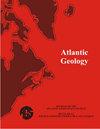美国新英格兰东南部纳肖巴地体和梅里马克带的碎屑锆石年龄与成因
IF 0.9
4区 地球科学
Q2 GEOLOGY
引用次数: 3
摘要
以断层为界的Nashoba–Putnam地体是新英格兰东南部一个变质的早古生代甘德弧/弧后复合体,位于东南部阿瓦隆系岩石和西北部梅里马克带中古生代沉积岩之间,被解释为甘德基底的覆盖层。对马萨诸塞州Nashoba地体的6个样品以及马萨诸塞州Merrimack带和新罕布什尔州东南部的7个样品进行了U–Pb碎屑锆石激光烧蚀电感耦合等离子体质谱分析,以研究其沉积年龄和物源。来自Nashoba地体的样本产生了约560至约540 Ma的主要年龄群体,与埃迪卡拉纪-寒武纪-佩诺布斯科特造山旋回及其基岩期间形成的当地来源的输入一致。然而,地体中最年轻的碎屑锆石与早奥陶世至中奥陶世一样年轻。根据最年轻的锆石年龄群和横切深成岩体,梅里马克带的六个地层沉积在约435至420 Ma之间,并产生了约470至443 Ma的大型年龄群。其中三个地层仅显示出冈瓦纳大陆的起源。另外三个具有冈瓦纳-劳伦混合信号,已知这是年轻和/或更向西沉积岩的典型信号,可能表明它们是梅里马克带(志留纪晚期至泥盆纪早期)最年轻的矿床,和/或沉积在相当于更向西的缅因州中部盆地。沿着梅里马克带和纳绍巴地体之间的断层接触,塔山组的碎屑锆石年龄群与这两个构造域不同,可能表明边界很复杂。本文章由计算机程序翻译,如有差异,请以英文原文为准。
Detrital zircon ages and the origins of the Nashoba terrane and Merrimack belt in southeastern New England, USA
The fault-bounded Nashoba–Putnam terrane, a metamorphosed early Paleozoic, Ganderian arc/back-arc complex in SE New England, lies between rocks of Avalonian affinity to the southeast and middle Paleozoic sedimentary rocks, interpreted as cover on Ganderian basement, in the Merrimack belt to the northwest. U–Pb detrital zircon laser ablation inductively coupled plasma mass spectrometry analysis were conduced on six samples from the Nashoba terrane in Massachusetts and seven samples associated with the Merrimack belt in Massachusetts and SE New Hampshire to investigate their depositional ages and provenance. Samples from the Nashoba terrane yielded major age populations between ~560 and ~540 Ma, consistent with input from local sources formed during the Ediacaran–Cambrian Penobscot orogenic cycle and its basement rocks. Youngest detrital zircons in the terrane, however, are as young as the Early to Middle Ordovician. Six formations from the Merrimack belt were deposited between ~435 and 420 Ma based on youngest zircon age populations and crosscutting plutons, and yielded large ~470–443 Ma age populations. Three of these formations show only Gondwanan provenance. Three others have a mixed Gondwanan-Laurentian signal, which is known to be typical for younger and/or more westerly sedimentary rocks and may indicate that they are the youngest deposits in the Merrimack belt (late Silurian to early Devonian) and/or have been deposited in the equivalent of the more westerly Central Maine basin. Detrital zircon age populations from the Tower Hill Formation, along the faulted contact between the Merrimack belt and Nashoba terrane, are different from either of these tectonic domains and may indicate that the boundary is complex.
求助全文
通过发布文献求助,成功后即可免费获取论文全文。
去求助
来源期刊

Atlantic Geology
GEOLOGY-
CiteScore
2.10
自引率
18.80%
发文量
0
审稿时长
>12 weeks
期刊介绍:
Atlantic Geology (originally Maritime Sediments, subsequently Maritime Sediments and Atlantic Geology) covers all aspects of the geology of the North Atlantic region. It publishes papers, notes, and discussions on original research and review papers, where appropriate to the regional geology.
 求助内容:
求助内容: 应助结果提醒方式:
应助结果提醒方式:


